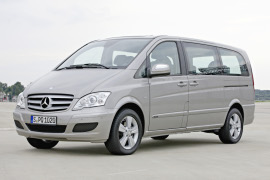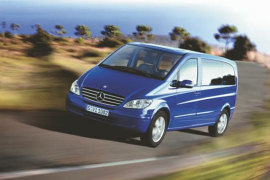MERCEDES BENZ VIANO Models/Series Timeline, Specifications & Photos
First production year: 2003
Engines: Diesel, Gasoline
Body style: Van
Mercedes-Benz upgraded the Viano in 2010 and improved its engine lineup to the Euro 5a norm, which was introduced in January 2011.
The European regulations forced the carmakers to improve their cars. Along with the engines, there were other several measures that had to be adopted by the manufacturers, such as new safety features and recycled materials used to build new vehicles. Even though Viano was based on an LCV, it had to fit into the passenger-cars emission standards. Along with the mandatory modifications, the carmaker reshaped some body parts.
While the daytime running lights started to be mandatory, Mercedes-Benz chose to use LEDs for them. It also introduced an option for bi-xenon headlamps, which were not mandatory but looked better on a premium MPV. Its reshaped bumper featured a center grille and two side-scoops, unlike the single grille system used for the non-facelifted version. In the rear, the taillights were shorter, and the upper side of the D-pillars was black.
Inside, Mercedes-Benz offered new features for the Viano, including a reversing camera, which displayed the image on the Command infotainment unit. There were some additional reading lamps on the ceiling for the rear passengers.
Under the hood, Mercedes-Benz installed a wide range of diesel engines and a V6 gasoline. Despite having the 7G-Tronic gearbox already developed, the carmaker insisted on using the older 5-speed automatic, known for its reliability.
The Viano had its origins in the Vito model released by Mercedes Benz. While the Vito was already known for its high utility for groups of six or more people, the Viano was even more comfortable and had many different features that enhanced the experience.
The Viano was available in three body sizes, Compact, Long or Extra Long. The van could carry up to 9 people, including the driver and the seats combination could differ depending on the car’s purpose. Some of them were internally modified for increased luxury.
The van was equipped with air-conditioning, remote-control central-locking, electric front windows and tinted glass. The Ambient trim level added a 12-volt refrigerator and leather upholstery, rear-air suspension with a self-leveling feature and seatbacks that could be folded to form a table.
The Viano was available with 3 diesel engine options, a 2.0-liter with 116 hp, a 2.2-liter with 50 hp, both mated to either a 6-speed manual or a 5-speed automatic gearbox. The fastest version came with a 3.0-liter engine developing 204 hp, rocketing the van to 62 mph in 9.7 seconds, compared to the smaller engines that were a bit slow.
Most of the Vianos were bought by companies for VIP duties, however, it was also excellent for large families during long trips due to the high level of comfort offered.

